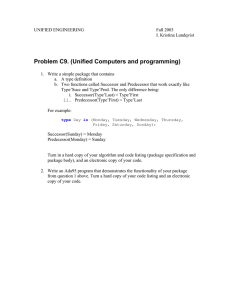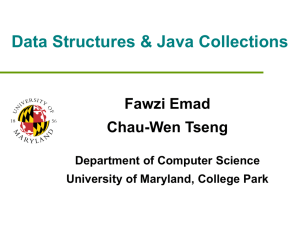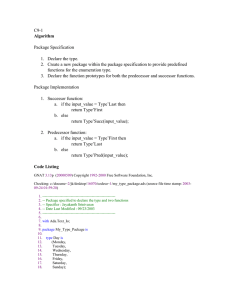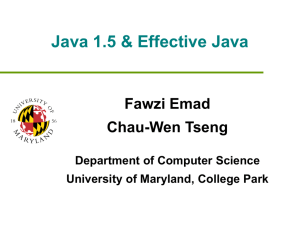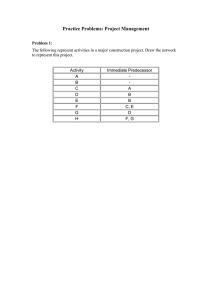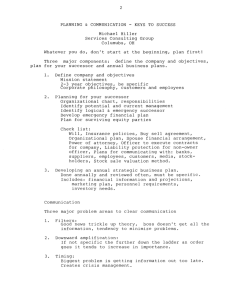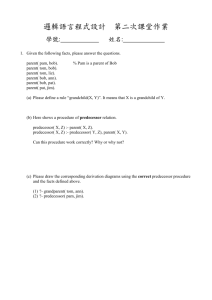Data Structures & Java Generics Nelson Padua-Perez Chau-Wen Tseng Department of Computer Science
advertisement
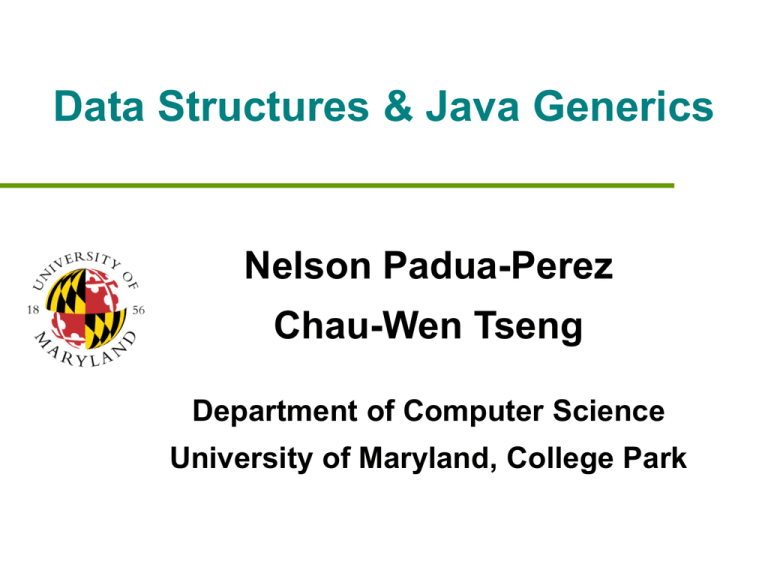
Data Structures & Java Generics
Nelson Padua-Perez
Chau-Wen Tseng
Department of Computer Science
University of Maryland, College Park
Algorithms and Data Structures
Algorithm
Sequence of steps used to solve a problem
Operates on collection of data
Each element of collection data structure
Data structure
Combination of simple / composite data types
Design information stored for each element
Choice affects characteristic & behavior of algorithm
May severely impact efficiency of algorithm
Data Structures
Taxonomy
Classification scheme
Based on relationships between element
Category
Linear
Hierarchical
Graph
Set
Relationship
one one
one many
many many
none none
Data Structures
Core operations
Add element
Remove element
Iterate through all elements
Compare elements
Linear Data Structures
One-to-one relationship between elements
Each element has unique predecessor
Each element has unique successor
Linear Data Structures
Core operations
Find first element (head)
Find next element (successor)
Find last element (tail)
Terminology
Head no predecessor
Tail no successor
Example Linear Data Structures
List
Collection of elements in order
Queue
Elements removed in order of insertion
First-in, First-out (FIFO)
Stack
Elements removed in opposite order of insertion
First-in, Last-out (FILO)
Hierarchical Data Structures
One-to-many relationship between elements
Each element has unique predecessor
Each element has multiple successors
Hierarchical Data Structures
Core operations
Find first element (root)
Find successor elements (children)
Find predecessor element (parent)
Terminology
Root no predecessor
Leaf no successor
Interior non-leaf
Children successors
Parent predecessor
Example Hierarchical Data Structures
Tree
Single root
Forest
Multiple roots
Binary tree
Tree with 0–2 children per node
Tree
Binary Tree
Graph Data Structures
Many-to-many relationship between elements
Each element has multiple predecessors
Each element has multiple successors
Graph Data Structures
Core operations
Find successor nodes
Find predecessor nodes
Find adjacent nodes (neighbors)
Terminology
Directed traverse edges in one direction
Undirected traverse edges in both directions
Neighbor adjacent node
Path sequence of edges
Cycle path returning to same node
Acyclic no cycles
Example Graph Data Structures
Undirected graph
Undirected edges
Directed graph
Directed edges
Directed acyclic graph (DAG)
Directed edges, no cycles
Undirected
Directed
DAG
Set Data Structures
No relationship between elements
Elements have no predecessor / successor
Only one copy of element allowed in set
Set A
Set B
Set C
Set Data Structures
Core operations
Set versions of core operations
Add set, remove set, compare set
Terminology
Subset elements contained by set
Union select elements in either set
Intersection select elements in both sets
Set difference select elements in one set only
Example Set Data Structures
Set
Basic set
Map
Map value to element in set
Hash Table
Maps value to element in set using hash function
h(n)
Set
Map
Hash Table
Java Collections Framework
Collection
Object that groups multiple elements into one unit
Also called container
Collection framework consists of
Interfaces
Abstract data type
Implementations
Reusable data structures
Algorithms
Reusable functionality
Core Collection Hierarchy
Collections Interface Implementations
General implementations
Primary public implementation
Example
List – ArrayList, LinkedList
Set – TreeSet, HashSet
Map – TreeMap, HashMap
Wrapper implementations
Combined with other interfaces
Example
synchronizedArrayList, unmodifiableHashMap
New Features in Java 1.5
Enumerated types
Enhanced for loop
Autoboxing & unboxing
Scanner
Generic types
Variable number of arguments (varargs)
Static imports
Annotations
Generics – Motivating Example
Problem
Utility classes handle arguments as Objects
Objects must be cast back to actual class
Casting can only be checked at runtime
Example
class A { … }
class B { … }
List myL = new List();
myL.add(new A());
// Add an object of type A
…
B b = (B) myL.get(0); // throws runtime exception
// java.lang.ClassCastException
Solution – Generic Types
Generic types
Provides abstraction over types
Can parameterize classes, interfaces, methods
Parameters defined using <x> notation
Examples
public class foo<x, y, z> { … }
public class List<String> { … }
Improves
Readability & robustness
Used in Java Collections Framework
Generics – Usage
Using generic types
Specify <type parameter> for utility class
Automatically performs casts
Can check class at compile time
Example
class A { … }
class B { … }
List<A> myL = new List<A>();
myL.add(new A());
// Add an object of type A
A a = myL.get(0);
// myL element class A
…
B b = (B) myL.get(0); // causes compile time error
Generics – Issues
Generics and subtyping
Even if class A extends class B
List<A> does not extend List<B>
Example
class B { … }
class A extends B { … }
// A is subtype of B
B b = new A();
// A used in place of B
List<B> myL = new List<A>(); // compile time error
// List<A> used in place of List<B>
// List<A> is not subtype of List<B>
